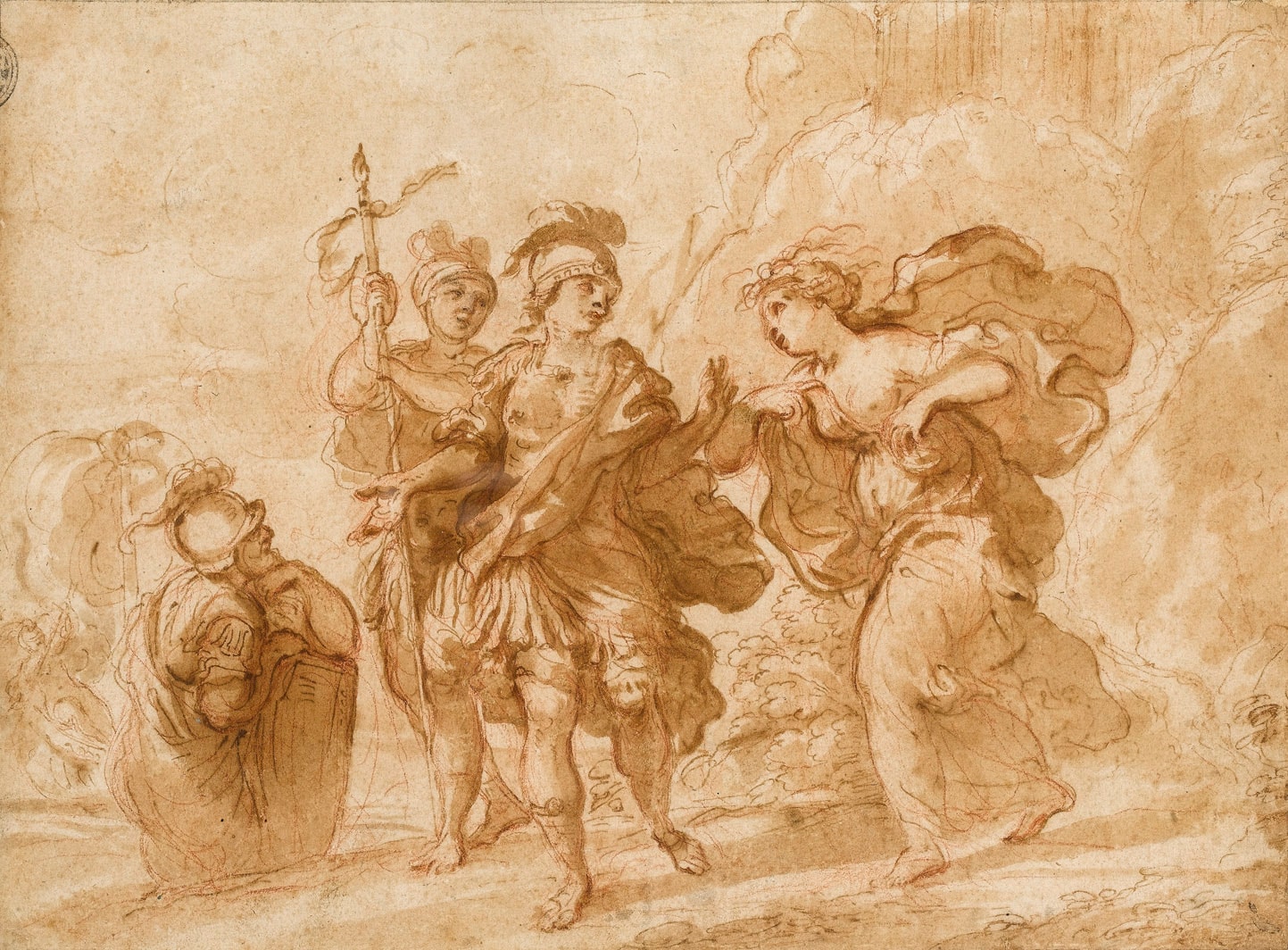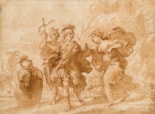Domenico Maria CANUTI
(Bologna 1620 - Bologna 1683)
The Parting of Rinaldo and Armida
Sold
Pen and brown ink and brown wash, over an underdrawing in red chalk.
Inscribed canuti f.18 on the verso, backed.
189 x 258 mm. (7 1/2 x 10 1/8 in.)
Inscribed canuti f.18 on the verso, backed.
189 x 258 mm. (7 1/2 x 10 1/8 in.)
Canuti was known for his inventive compositions, and produced a number of drawings on literary or mythological themes, most of which do not seem to have been intended as studies for paintings and may have been produced as finished works of art for sale to collectors.
The present sheet is one of several drawings by Canuti depicting scenes from the story of Rinaldo and Armida, taken from Torquato Tasso’s epic poem Gerusalemme Liberata. These include another drawing of The Parting of Rinaldo and Armida, different in composition but very similar in style and technique to the present sheet, in the Louvre, as well as a drawing in the Kupferstichkabinett in Berlin and two drawings in the Nationalmuseum in Stockholm. Other stylistically comparable drawings by Canuti include another study of a subject from Tasso (possibly The Condemnation of Sophronia), and a Battle Scene, both in the Louvre, a group of five drawings of scenes from the life of Saint George in Stockholm and a drawing of The Sack of Troy in a private collection.
The present sheet is one of several drawings by Canuti depicting scenes from the story of Rinaldo and Armida, taken from Torquato Tasso’s epic poem Gerusalemme Liberata. These include another drawing of The Parting of Rinaldo and Armida, different in composition but very similar in style and technique to the present sheet, in the Louvre, as well as a drawing in the Kupferstichkabinett in Berlin and two drawings in the Nationalmuseum in Stockholm. Other stylistically comparable drawings by Canuti include another study of a subject from Tasso (possibly The Condemnation of Sophronia), and a Battle Scene, both in the Louvre, a group of five drawings of scenes from the life of Saint George in Stockholm and a drawing of The Sack of Troy in a private collection.
Domenico Maria Canuti trained with Guido Reni, Guercino and Giovanni Andrea Sirani in Bologna where, apart from two periods spent in Rome in the 1640’s and 1670’s and some time spent in Padua in the 1660’s, he worked for most of his career. His first known painting is a canvas of The Ecstasy of Saint Cecilia for a church in Imola, and although he continued to paint both altarpieces and easel pictures throughout his career, it was as a ceiling fresco painter that Canuti came to be best known. Among his most important patrons were the Pepoli, a noble Bolognese family who commissioned a series of frescoes for the Palazzo Pepoli Campogrande. These included an Apotheosis of Hercules on Olympus for the ceiling of the gran salone of the palace, painted between 1660 and 1670, and the artist’s most famous work. The fame of this project led to a number of Roman commissions, and Canuti worked in Rome for five years from 1672 onwards. Among his patrons were the Colonna and Altieri familes, and he also painted a vault fresco of The Apotheosis of Saint Dominic for the church of Santi Domenico e Sisto. In 1676 he became a member of the Accademia di San Luca in Rome, but was back in Bologna the following year. The remainder of his flourishing career was spent working mainly on the decoration of the monastery of San Michele in Bosco. Among his many students was Giuseppe Maria Crespi.




